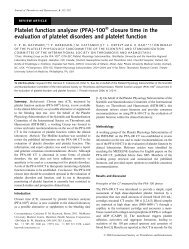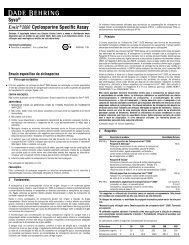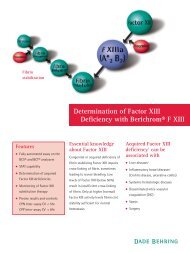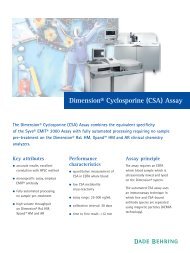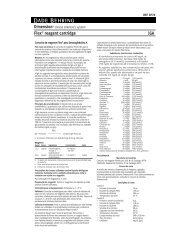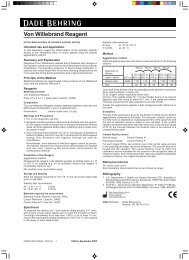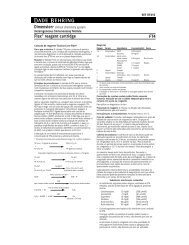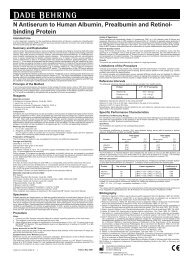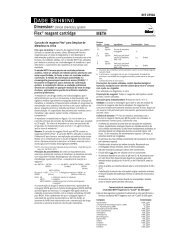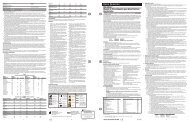Controle de ProteÃnas LC - Liquor e Urina - Medcorp
Controle de ProteÃnas LC - Liquor e Urina - Medcorp
Controle de ProteÃnas LC - Liquor e Urina - Medcorp
Create successful ePaper yourself
Turn your PDF publications into a flip-book with our unique Google optimized e-Paper software.
N/T Protein Control <strong>LC</strong>Inten<strong>de</strong>d UseN/T Protein Control <strong>LC</strong> is used for control of accuracy and precision in immunonephelometric <strong>de</strong>terminationsof IgG in urine and CSF, IgA in CSF, IgM in CSF, transferrin in urine, albumin in urine andCSF, α 2-macroglobulin in urine and CSF, immunoglobulin light chains (types kappa and lambda) inurine, α 1-microglobulin in urine, total protein in urine and CSF, and β-trace protein using the BN*systems, as well as in the immunoturbidimetric <strong>de</strong>termination of IgG in CSF, and albumin in urine andCSF, using the TurbiTimeSystem.ReagentMaterials provi<strong>de</strong>dN/T Protein Control <strong>LC</strong>, Co<strong>de</strong> No. OQLW3 vials, each for 1.0 m<strong>LC</strong>omposition and StandardizationN/T Protein Control <strong>LC</strong> is a lyophilized control prepared from polygeline and rabbit albumin withurinary and serum proteins of human origin.The concentrations of the listed proteins were calibrated against different protein reference preparationsin the appropriate methods and are lot-<strong>de</strong>pen<strong>de</strong>nt.The assigned values and confi<strong>de</strong>nce intervals are given on the enclosed table. The values can beread into the BN ProSpec ® System via diskette (Co<strong>de</strong> No. OVLP).Protein reference preparations used:CRM 470 for IgG, IgA, IgM, transferrin, albumin and α 2-macroglobulin (1,2);N Protein Standard SL from Da<strong>de</strong> Behring Marburg GmbH for immunoglobulin light chains, typeskappa and lambda;Highly purified proteins and earlier protein standard preparations of Da<strong>de</strong> Behring Marburg GmbHfor α 1-microglobulin and β-trace protein.Preservative: Sodium azi<strong>de</strong> (< 1 g/L)Warnings and Precautions1. For in vitro diagnostic use.2. Reagents containing sodium azi<strong>de</strong> must be handled with due caution:Do not ingest or allow to contact skin or mucous membranes! Sodium azi<strong>de</strong> can form explosiveazi<strong>de</strong>s when contacting heavy metals such as copper or lead.3. N/T Protein Control <strong>LC</strong> contains components of human origin. Blood samples of donors of theconcerned starting material are tested for hepatitis B surface antigen, anti-HCV, anti-HIV1 andanti-HIV2 by FDA-required testing. Only starting materials from donors with negative findings areused for manufacture.Nevertheless, since absence of infectious agents cannot be proven, all materials obtained fromhuman tissue or body fluids should be handled with due care, observing the precautions recommen<strong>de</strong>dfor biohazardous material (3).Preparation of the ReagentDissolve the vial contents in exactly 1.0 mL of distilled water. Invert gently to mix. Avoid foam formationand vigorous shaking. The product is ready for use after the contents have dissolved to give aclear solution (time required approx. 30 min.)The reagents should have reached room temperature (+15 to +25°C) before assay on the BN*A andBN* 100 Systems. Reagents stored at +2 to +8°C can be used for immediate assay on the BN* II andBN ProSpec ® System.Storage and StabilityStability at +2 to +8 °C:The expiry date is given on the label;Stability after reconstitution of the lyophilized material:14 days if stored tightly closed at +2 to +8°C directly after use. Do not freeze.The “on-board” stability of the N/T Protein Control <strong>LC</strong> on the BN ProSpec ® System is stated in theinstruction manual of the system.Discard the control if any turbidity or sediment appears.ProcedureN/T Protein Control <strong>LC</strong> is run and evaluated in the same way as the patient samples. However, totalprotein in urine and CSF must be <strong>de</strong>termined from a 1:100 dilution.The assigned values and confi<strong>de</strong>nce intervals for the particular lot are provi<strong>de</strong>d in the enclosed tableas well as on the BN ProSpec ® lot data diskettes (Co<strong>de</strong> No. OVLP).NoteThe stated assigned values are for accuracy control. If used for precision control, the user shoul<strong>de</strong>stablish the control values and control limits in a preliminary period.For <strong>de</strong>tails regarding the principle of the assay method, any additional materials required, the use ofN/T Protein Control <strong>LC</strong> for internal quality control, the calculation of the analytical results, and theperformance characteristics of the tests please consult the reagent package inserts.Bibliography1. Baudner S, Bienvenu J, Blirup-Jensen S, et al. The certification of a matrix reference material forimmunochemical measurement of 14 human serum proteins. CRM 470. Brussels: CommunityBureau of Reference, Commission of the European Communities. BCR Information, ReferenceMaterials. 1993 report EUR 15243 EN (ISSN 1018-5593): 1-1722. Whicher JT, Ritchie RF, Johnson MA, et al. New international reference preparation for proteins inhuman serum (RPPHS 5), Clin Chem 1994; 40: 934-83. U.S. Department of Health and Human Services CDC, Biosafety in Microbiological and BiomedicalLaboratories, HHS Publication (CDC) 93-8395; 1999; Section II; 8-16* BN is a tra<strong>de</strong>mark of Da<strong>de</strong> Behring Marburg GmbH in the USA.BN ProSpec is a registered tra<strong>de</strong>mark of Da<strong>de</strong> Behring Marburg GmbH in the USA, in Germany andother countries.Da<strong>de</strong> Behring Marburg GmbHEmil-von-Behring-Str. 76D-35041 MarburgUSA Distributor:Da<strong>de</strong> Behring Inc.Newark, DE 19714 U.S.A.Edition November 2002N/T Protein-Kontrolle <strong>LC</strong>AnwendungsbereichN/T Protein-Kontrolle <strong>LC</strong> dient zur Richtigkeits- und Präzisionskontrolle von immunnephelometrischenBestimmungen <strong>de</strong>r Proteine IgG im Urin und <strong>Liquor</strong>, IgA im <strong>Liquor</strong>, IgM im <strong>Liquor</strong>, Transferrinim Urin, Albumin im Urin und <strong>Liquor</strong>, α 2-Makroglobulin im Urin und <strong>Liquor</strong>, Immunglobulin-Leichtketten,Typ Kappa und Typ Lambda im Urin, α 1-Mikroglobulin im Urin, Gesamtprotein im Urin und <strong>Liquor</strong>und β-Trace Protein mit <strong>de</strong>n BN* Systemen, sowie für die immunturbidimetrische Bestimmung vonIgG im <strong>Liquor</strong> und Albumin im Urin und <strong>Liquor</strong> mit <strong>de</strong>m TurbiTimeSystem.ReagenzInhalt <strong>de</strong>r Han<strong>de</strong>lspackungN/T Protein-Kontrolle <strong>LC</strong>, Bestell-Nr. OQLW3 Flaschen für je 1,0 mlZusammensetzung und StandardisierungN/T Protein-Kontrolle <strong>LC</strong> ist ein Lyophilisat aus Polygeline und Kaninchen-Albumin mit Urin- undSerumproteinen humanen Ursprungs.Die Konzentrationen <strong>de</strong>r <strong>de</strong>klarierten Proteine wur<strong>de</strong>n unter Bezugnahme auf verschie<strong>de</strong>ne Protein-Referenzpräparate in <strong>de</strong>n entsprechen<strong>de</strong>n Metho<strong>de</strong>n kalibriert und sind chargenabhängig.Die Sollwerte und Vertrauensbereiche wer<strong>de</strong>n auf <strong>de</strong>r beiliegen<strong>de</strong>n Tabelle angegeben. Die Datenkönnen am BN ProSpec ® System per Diskette (Bestell-Nr. OVLP) eingelesen wer<strong>de</strong>n.Verwen<strong>de</strong>te Protein-Referenzpräparate:CRM 470 für IgG, IgA, IgM, Transferrin, Albumin und α 2-Makroglobulin (1,2);N Protein Standard SL <strong>de</strong>r Da<strong>de</strong> Behring Marburg GmbH für Immunglobulin-Leichtketten, Typ Kappaund Typ Lambda;Hochgereinigte Proteine und frühere Protein-Standard-Präparate <strong>de</strong>r Da<strong>de</strong> Behring MarburgGmbH für α 1-Mikroglobulin und β-Trace Protein.Konservierungsmittel: Natriumazid (< 1 g/l)Warnhinweise und Vorsichtsmaßnahmen1. Nur zur in-vitro-diagnostischen Anwendung.2. Beim Umgang mit Natriumazid-haltigen In-vitro-Diagnostica ist zu beachten:Verschlucken o<strong>de</strong>r Kontakt mit Haut o<strong>de</strong>r Schleimhäuten vermei<strong>de</strong>n! Natriumazid kann mitSchwermetallen, wie Kupfer o<strong>de</strong>r Blei, explosive Azi<strong>de</strong> bil<strong>de</strong>n.3. N/T Protein-Kontrolle <strong>LC</strong> enthält Komponenten humanen Ursprungs. Blutproben <strong>de</strong>r Spen<strong>de</strong>r <strong>de</strong>sbetreffen<strong>de</strong>n Ausgangsmaterials wur<strong>de</strong>n auf Hepatitis-Bs-Antigen, Anti-HCV, Anti-HIV1 und Anti-HIV2 untersucht. Für die Herstellung wur<strong>de</strong>n nur Ausgangsmaterialien von Spen<strong>de</strong>rn mit negativemBefund verwen<strong>de</strong>t.Unabhängig davon sollten alle aus menschlichem Gewebe o<strong>de</strong>r Körperflüssigkeiten gewonnenenMaterialien wegen nie völlig auszuschließen<strong>de</strong>r Gefährdung durch Krankheitserreger mit angemessenerSorgfalt unter Einhaltung <strong>de</strong>r bei Biogefährdung empfohlenen Sicherheitsmaßnahmengehandhabt wer<strong>de</strong>n (3).Vorbereitung <strong>de</strong>s ReagenzesDer Inhalt einer Flasche wird mit genau 1,0 ml <strong>de</strong>stilliertem Wasser aufgelöst. Den Inhalt <strong>de</strong>r Flaschedurch vorsichtiges Schwenken durchmischen. Schaumbildung und heftiges Schütteln sind zu vermei<strong>de</strong>n.Nach<strong>de</strong>m <strong>de</strong>r Inhalt klar gelöst ist, kann das Produkt eingesetzt wer<strong>de</strong>n (Zeitbedarf ca. 30 min).Reagenzien sollen vor <strong>de</strong>r Messung am BN*A und BN* 100 System Raumtemperatur (+15 bis +25 °C)erreicht haben. Am BN* II und BN ProSpec ® System können bei +2 bis +8 °C gelagerte Reagenziendirekt zur Bestimmung eingesetzt wer<strong>de</strong>n.Haltbarkeit und LagerungsbedingungenLagerungsdauer bei +2 bis +8 °C:Das Haltbarkeitsdatum ist auf <strong>de</strong>m Etikett angegeben;Stabilität nach Rekonstitution <strong>de</strong>s Lyophilisates:14 Tage, sofern unmittelbar nach Gebrauch wie<strong>de</strong>r dicht verschlossen bei +2 bis +8 °C gelagert. N/TProtein-Kontrolle <strong>LC</strong> darf nicht eingefroren wer<strong>de</strong>n.Die "on-board" Stabilität <strong>de</strong>r N/T Protein-Kontrolle <strong>LC</strong> auf <strong>de</strong>m BN ProSpec ® System ist in <strong>de</strong>r Bedienungsanleitung<strong>de</strong>s Systems angegeben.N/T Protein-Kontrolle <strong>LC</strong> soll verworfen wer<strong>de</strong>n, wenn sich eine Trübung o<strong>de</strong>r ein Sediment zeigt.TestdurchführungN/T Protein-Kontrolle <strong>LC</strong> wird im Testansatz und bei <strong>de</strong>r Auswertung wie die Patientenproben in <strong>de</strong>nentsprechen<strong>de</strong>n Assay-Protokollen behan<strong>de</strong>lt. Die Gesamtproteinbestimmung im Urin und <strong>Liquor</strong>muss im Gegensatz dazu mit einer 1:100 Verdünnung durchgeführt wer<strong>de</strong>n.Die Sollwerte und Vertrauensbereiche sind in <strong>de</strong>r beiliegen<strong>de</strong>n Tabelle sowie auf <strong>de</strong>n BN ProSpec ®Chargenangaben-Disketten (Bestell-Nr. OVLP) chargenabhängig angegeben.HinweisDie angegebenen Sollwerte dienen zur Richtigkeitskontrolle. Bei <strong>de</strong>r Verwendung als Präzisionskontrollesollten in einer Vorperio<strong>de</strong> Kontrollwert und Kontrollgrenzen vom Anwen<strong>de</strong>r ermittelt wer<strong>de</strong>n.Nähere Angaben zum Prinzip <strong>de</strong>s Messverfahrens, zu zusätzlich benötigten Materialien, zur Anwendung<strong>de</strong>r N/T Protein-Kontrolle <strong>LC</strong> in <strong>de</strong>r internen Qualitätskontrolle, zur Berechnung <strong>de</strong>r Analysenergebnisseund zu <strong>de</strong>n Leistungsmerkmalen <strong>de</strong>r Teste sind <strong>de</strong>r Packungsbeilage <strong>de</strong>r Reagenzien zuentnehmen.LiteraturSiehe englischen Text.* BN ist eine Marke <strong>de</strong>r Da<strong>de</strong> Behring Marburg GmbH in <strong>de</strong>n USA.BN ProSpec ist eine eingetragene Marke <strong>de</strong>r Da<strong>de</strong> Behring Marburg GmbH in <strong>de</strong>n USA, in Deutschlandund an<strong>de</strong>ren Län<strong>de</strong>rn.Da<strong>de</strong> Behring Marburg GmbHEmil-von-Behring-Str. 76D-35041 MarburgAusgabe November 2002OQLW G13 C0540 (164) W 1OQLW G13 C0540 Satzdatei104.11.2002, 16:57 Uhr
N/T Contrôle Protéines <strong>LC</strong>Domaine d’utilisationLe N/T Contrôle Protéines <strong>LC</strong> permet un contrôle d’exactitu<strong>de</strong> et <strong>de</strong> précision <strong>de</strong>s dosages immunonéphélémétriquesà l’ai<strong>de</strong> <strong>de</strong>s systèmes BN* <strong>de</strong>s protéines suivantes : IgG dans l’urine et le <strong>LC</strong>R, IgAdans le <strong>LC</strong>R, IgM dans le <strong>LC</strong>R, transferrine dans l’urine, albumine dans l’urine et le <strong>LC</strong>R, α 2-macroglobulinedans l’urine et le <strong>LC</strong>R, chaînes légères <strong>de</strong>s immunoglobulines <strong>de</strong> types kappa et lambda dansl’urine, α 1-microglobuline dans l’urine, protéines totales dans l’urine et le <strong>LC</strong>R, et β-trace protéine.Il permet également un contrôle d’exactitu<strong>de</strong> et <strong>de</strong> précision <strong>de</strong>s dosages immuno-turbidimétriques àl’ai<strong>de</strong> du TurbiTimeSystem <strong>de</strong> l’IgG dans le <strong>LC</strong>R et <strong>de</strong> l’albumine dans l’urine et le <strong>LC</strong>R.RéactifConditionnementN/T Contrôle Protéines <strong>LC</strong>, co<strong>de</strong> OQLW3 flacons <strong>de</strong> 1,0 mlComposition et standardisationLe N/T Contrôle Protéines <strong>LC</strong> est un lyophilisat <strong>de</strong> polygéline et d’albumine <strong>de</strong> lapin enrichi en protéinessériques et urinaires d’origine humaine.Les concentrations <strong>de</strong>s protéines indiquées sont étalonnées par rapport à différentes préparations <strong>de</strong>référence protéiques correspondant aux métho<strong>de</strong>s utilisées, et varient selon les lots.Les valeurs théoriques et les domaines <strong>de</strong> confiance sont indiqués dans le tableau ci-joint. Ellespeuvent être lues sur disquette (co<strong>de</strong> OVLP) par le système BN ProSpec ® .Préparations <strong>de</strong> référence protéiques utilisées :CRM 70 pour les IgG, les IgA, les IgM, la transferrine, l’albumine et l’α 2-macroblobuline (1,2) ;N Standard Protéines SL <strong>de</strong> Da<strong>de</strong> Behring Marburg GmbH pour les chaînes légères <strong>de</strong>s immunoglobulines<strong>de</strong> type kappa et <strong>de</strong> type lambda ;Protéines hautement purifiées et anciennes préparations standard protéiques <strong>de</strong> Da<strong>de</strong> BehringMarburg GmbH pour l’α 1-microglobuline et la β-trace protéine.Agent <strong>de</strong> conservation : azi<strong>de</strong> <strong>de</strong> sodium (< 1 g/l)Mises en gar<strong>de</strong> et précautions d’emploi1. Réservé à un usage in vitro.2. Les réactifs contenant <strong>de</strong> l’azi<strong>de</strong> <strong>de</strong> sodium doivent être manipulés avec précaution :ne pas avaler et éviter tout contact avec la peau ou les muqueuses ! L’azi<strong>de</strong> <strong>de</strong> sodium peut<strong>de</strong>venir explosif au contact <strong>de</strong>s métaux lourds, comme le cuivre ou le plomb.3. Certains composants du N/T Contrôle Protéines <strong>LC</strong> sont d’origine humaine. Les échantillons <strong>de</strong>sang <strong>de</strong> donneurs utilisés pour la préparation <strong>de</strong> ce réactif sont testés vis-à-vis <strong>de</strong> l’antigène <strong>de</strong>surface <strong>de</strong> l’Hépatite B, <strong>de</strong> l’anticorps anti-VHC, <strong>de</strong> l’anticorps anti-VIH1 et <strong>de</strong> l’anticorps anti-VIH2. Seuls les échantillons <strong>de</strong>s donneurs trouvés négatifs ont été utilisés.Indépendamment <strong>de</strong> cela, toutes les préparations obtenues à partir <strong>de</strong> tissus ou <strong>de</strong> liqui<strong>de</strong>s humainsdoivent être manipulées avec les précautions nécessaires en cas <strong>de</strong> risque biologique,dans la mesure où l’on ne peut exclure totalement un risque d’infection (3).Préparation du réactifReconstituer le contenu d’un flacon avec exactement 1,0 ml d’eau distillée. Homogénéiser la solutionen retournant le flacon avec précaution ; ne pas l’agiter fortement et éviter la formation <strong>de</strong> mousse. Leréactif est prêt à l’emploi lorsque la solution est limpi<strong>de</strong> (après environ 30 min).Porter le réactif à la température ambiante (+15/+25°C) avant <strong>de</strong> l’utiliser sur les systèmes BN*A etBN*100. Sur le BN*II et le BN ProSpec ® , il peut être directement utilisé à sa température <strong>de</strong> conservation,comprise entre +2 et +8°C.Validité et conditions <strong>de</strong> conservationTempérature <strong>de</strong> conservation à +2/+8°C :la date <strong>de</strong> péremption est indiquée sur l’étiquette du flacon.Stabilité après reconstitution du lyophilisat :14 jours, à condition <strong>de</strong> bien refermer le flacon immédiatement après emploi, et <strong>de</strong> le replacer à +2/+8°C. Ne pas congeler le N/T Contôle Protéines <strong>LC</strong>.La stabilité « on-board » du N/T Contrôle Protéines <strong>LC</strong> sur le système BN ProSpec ® est indiqué dansle manuel d’utilisation du système.Jeter le N/T Contôle Protéines <strong>LC</strong> s’il <strong>de</strong>vient trouble ou présente une sédimentation.Réalisation du testTraiter le N/T Contrôle Protéines <strong>LC</strong> comme un échantillon <strong>de</strong> patient selon le protocole indiqué,aussi bien pour la réalisation du test que pour l’exploitation <strong>de</strong>s résultats. Par contre, le dosage <strong>de</strong>sprotéines totales dans l’urine et le <strong>LC</strong>R doit s’effectuer à une dilution au 1/100.Les valeurs théoriques et les domaines <strong>de</strong> confiance qui varient selon les lots sont indiqués dans letableau ci-joint ainsi que sur la disquette <strong>de</strong>s données (co<strong>de</strong> OVLP) du système BN ProSpec ® .RemarqueLes valeurs théoriques indiquées permettent d’effectuer un contrôle d’exactitu<strong>de</strong>. Pour effectuer uncontrôle <strong>de</strong> précision, l’utilisateur <strong>de</strong>vra préalablement déterminer une valeur <strong>de</strong> contrôle ainsi que<strong>de</strong>s limites <strong>de</strong> contrôle.Pour plus <strong>de</strong> précisions sur le principe <strong>de</strong> mesure, les réactifs complémentaires nécessaires,l’utilisation du N/T Contrôle Protéines <strong>LC</strong> pour le contrôle <strong>de</strong> qualité interne, le calcul <strong>de</strong>s résultatsd’analyse ainsi que les caractéristiques du test, se reporter aux fiches techniques <strong>de</strong>s réactifs utilisés.LittératureCf. texte anglais.* BN est une marque <strong>de</strong> Da<strong>de</strong> Behring Marburg GmbH aux USA.BN ProSpec est une marque déposée <strong>de</strong> Da<strong>de</strong> Behring Marburg GmbH aux USA, en Allemagne etdans d’autres pays.Da<strong>de</strong> Behring Marburg GmbHEmil-von-Behring-Str. 76D-35041 MarburgN/T Controllo Proteine <strong>LC</strong>Uso previstoL’N/T Controllo Proteine <strong>LC</strong> viene utilizzato per il controllo di accuratezza e precisione <strong>de</strong>lle <strong>de</strong>terminazioniimmunonefelometriche <strong>de</strong>lle IgG nelle urine e nel liquor, IgA nel liquor, IgM nel liquor, transferrinanelle urine, albumina nelle urine e nel liquor, α 2-macroglobulina nelle urine e nel liquor, cateneleggere <strong>de</strong>lle immunoglobuline, tipo kappa e tipo lambda nelle urine, α 1-microglobulina nelle urine,proteine totali nelle urine e nel liquor e β-trace protein utilizzando i sistemi BN*, ed inoltre per la<strong>de</strong>terminazione immunoturbidimetrica <strong>de</strong>lle IgG nel liquor e <strong>de</strong>ll’albumina nelle urine e nel liquorutilizzando il sistema TurbiTime.ReagentiContenuto <strong>de</strong>lla confezioneN/T Controllo Proteine <strong>LC</strong>, codice OQLW3 flaconi da 1.0 mL ciascunoComposizione e standardizzazioneL’N/T Controllo Proteine <strong>LC</strong> è un liofilizzato costituito da poligelina ed albumina di coniglio con proteineurinarie e sieriche di origine umana.Le concentrazioni <strong>de</strong>lle proteine indicate, sono state calibrate contro differenti preparati proteici diriferimento con il corrispon<strong>de</strong>nte metodo e variano con il lotto.I valori teorici e gli intervalli di accettabilità sono indicati nella tabella acclusa. I dati possono essereinseriti nel sistema BN ProSpec ® tramite dischetto (codice OVLP).Preparati proteici di riferimento utilizzati:CRM 470 per IgG, IgA, IgM, transferrina, albumina e α 2-macroglobulina (1,2).N Proteine Standard SL <strong>de</strong>lla Da<strong>de</strong> Behring Marburg GmbH per le catene leggere <strong>de</strong>lle immunoglobuline,tipo kappa e tipo lambda.Proteine altamente purificate e prece<strong>de</strong>nti preparati proteici standard <strong>de</strong>lla Da<strong>de</strong> Behring MarburgGmbH per α 1-microglobulina e β-trace protein.Conservante: sodio azi<strong>de</strong> (< 1g/L)Avvertenze e precauzioni1. Solo per uso diagnostico in vitro.2. Quando si impiegano diagnostici in vitro contenenti sodio azi<strong>de</strong>, osservare le seguenti precauzioni:Non ingerire ed evitare il contatto con la pelle e le mucose! La sodio azi<strong>de</strong>, a contatto con metallipesanti come rame o piombo, può formare azidi esplosive.3. L’N/T Controllo Proteine <strong>LC</strong> contiene componenti di origine umana. I campioni di sangue <strong>de</strong>i donatoriutilizzati per la preparazione <strong>de</strong>l reagente sono stati controllati per la presenza <strong>de</strong>ll’antigenedi superficie <strong>de</strong>l virus <strong>de</strong>ll’epatite B e <strong>de</strong>gli anticorpi anti-HCV, anti-HIV1 ed anti-HIV2. Solo i campionirisultati negativi sono stati utilizzati per la produzione.Tuttavia, tutti i <strong>de</strong>rivati da tessuti o fluidi umani <strong>de</strong>vono essere trattati con le necessarie precauzionirispettando le norme di sicurezza sul rischio biologico, in quanto non è possibile esclu<strong>de</strong>re conassoluta certezza il pericolo di agenti patogeni(3).Preparazione <strong>de</strong>l reagenteRicostituire il contenuto di un flacone con esattamente 1 mL di acqua distillata. Capovolgere <strong>de</strong>licatamenteper miscelare. Evitare l’agitazione troppo energica e la formazione di schiuma. Il prodotto èpronto all’uso quando la soluzione si presenta limpida (tempo richiesto ca. 30 minuti).Portare i reagenti a temperatura ambiente (+15/+25°C) prima di utilizzarli sui sistemi BN* A e BN*100. I reagenti conservati a +2/+8°C possono essere utilizzati subito sui sistemi BN* II e BN Pro-Spec ® .Conservazione e stabilitàConservazione a +2/+8°C:la data di sca<strong>de</strong>nza è indicata sull’etichetta.Stabilità dopo ricostituzione <strong>de</strong>l liofilizzato:14 giorni, se conservato ben chiuso a +2/+8°C, subito dopo l’uso. Non congelare.La stabilità “on-board” <strong>de</strong>ll’N/T Controllo Proteine <strong>LC</strong> sul sistema BN ProSpec ® è indicata nel manualed’uso <strong>de</strong>l sistema.L’N/T Controllo Proteine <strong>LC</strong> che presenta torbidità o sedimento <strong>de</strong>ve essere eliminato.Esecuzione <strong>de</strong>l testL’N/T Controllo Proteine <strong>LC</strong> <strong>de</strong>ve essere analizzato e valutato allo stesso modo <strong>de</strong>i campioni in esamesecondo il corrispon<strong>de</strong>nte protocollo analitico. Le proteine totali nelle urine e nel liquor <strong>de</strong>vono,invece, essere <strong>de</strong>terminate ad una diluizione 1:100.I valori teorici e gli intervalli di accettabilità sono riportati nella tabella acclusa e nel dischetto con i datidi lotto per BN ProSpec ® (codice OVLP).NotaI valori teorici indicati servono per il controllo di accuratezza. Se utilizzati per il controllo di precisione,l’utilizzatore dovrebbe dapprima fissare i propri valori e limiti di controllo.Per maggiori informazioni sul principio <strong>de</strong>l metodo, il materiale supplementare necessario, l’uso<strong>de</strong>ll’N/T Controllo Proteine <strong>LC</strong> per il controllo di qualità interno, il calcolo <strong>de</strong>i risultati analitici e lecaratteristiche <strong>de</strong>l test, consultare il foglietto illustrativo <strong>de</strong>i reagenti.BibliografiaVedi pagina 1.* BN è un marchio <strong>de</strong>lla Da<strong>de</strong> Behring Marburg GmbH negli USABN ProSpec è un marchio registrato <strong>de</strong>lla Da<strong>de</strong> Behring Marburg GmbH negli USA, in Germania enegli altri Paesi.Da<strong>de</strong> Behring Marburg GmbHEmil-von-Behring-Str. 76D-35041 MarburgEdizione Novembre 2002Edition Novembre 2002OQLW G13 C0540 (164) W 2OQLW G13 C0540 Satzdatei204.11.2002, 16:57 Uhr
N/T Control <strong>de</strong> Proteína <strong>LC</strong>Campos <strong>de</strong> aplicaciónEl N/T Control <strong>de</strong> proteínas <strong>LC</strong> sirve para controlar la presición y la exactitud <strong>de</strong> las <strong>de</strong>terminacionesinmunoquímicas <strong>de</strong> las proteínas, IgG en orina y en líquido cefalorraquí<strong>de</strong>o, IgA en líquido cefalorraquí<strong>de</strong>o,IgM en líquido cefalorraquí<strong>de</strong>o, transferrina en orina, albúmina en orina y líquido cefalorraquí<strong>de</strong>o,α 2- macroglobulina en orina y líquido cefalorraquí<strong>de</strong>o, ca<strong>de</strong>nas livianas, tipo kappa y tipolambda, <strong>de</strong> las inmunoglobulinas en orina, α 1- microglobulina en orina, proteínas totales en orina ylíquido cefalorraquí<strong>de</strong>o y <strong>de</strong> la proteína β-trace, con los sistemas BN*, así como para la <strong>de</strong>terminacióninmunoturbidimétrica <strong>de</strong> IgG en líquido cefalorraquí<strong>de</strong>o y albúmina en orina y líquido cefalorraquí<strong>de</strong>ocon el TurbiTimeSystem.ReactivosContenido <strong>de</strong>l envase comercialN/T Control <strong>de</strong> proteínas <strong>LC</strong>, N° <strong>de</strong> pedido OQLW3 frascos c/u con 1,0 mlComposición y estandarizaciónEl N/T Control <strong>de</strong> proteínas <strong>LC</strong> es un liofilizado obtenido a partir <strong>de</strong> poligelina y albúmina <strong>de</strong> conejocon proteínas <strong>de</strong> orina y <strong>de</strong> suero <strong>de</strong> origen humano.Las concentraciones <strong>de</strong> las proteínas <strong>de</strong>claradas se calibraron con relación a diferentes preparados<strong>de</strong> referencia, usando el método correspondiente y son <strong>de</strong>pendientes <strong>de</strong>l lote.Los valores teóricos y los rangos <strong>de</strong> confianza vienen dados en la Tabla adjunta. Los datos pue<strong>de</strong>nser leídos en el sistema BN ProSpec ® por disquete (N° <strong>de</strong> pedido OVLP).Preparados <strong>de</strong> proteínas <strong>de</strong> referencia utilizados:CRM 470 para IgG, IgA, IgM, transferrina, albúmina, α 2- macroglobulina, (1, 2);N Proteína estándar SL <strong>de</strong> Da<strong>de</strong> Behring Marburg GmbH para las ca<strong>de</strong>nas livianas, tipo kappa ytipo lambda, <strong>de</strong> las inmunoglobulinas;Proteínas <strong>de</strong> alta pureza y preparados anteriores <strong>de</strong> proteína estándar <strong>de</strong> Da<strong>de</strong> Behring GmbHpara α 1- microglobulina y proteína β-trace.Agente <strong>de</strong> conservación: Azida sódica (< 1 g/l)Advertencias y medidas <strong>de</strong> seguridad:1. Sólo para ser utilizado en diagnósticos in-vitro.2. En el manejo <strong>de</strong> diagnósticos in-vitro que contengan azida sódica <strong>de</strong>be observarse lo siguiente:No ingerir y evitar contacto con la piel y mucosas. La azida sódica pue<strong>de</strong> formar azidas explosivascon metales como cobre y plomo.3. El N/T Control <strong>de</strong> proteínas <strong>LC</strong> contiene componentes <strong>de</strong> origen humano. Las muestras <strong>de</strong> sangre<strong>de</strong> los donantes para el material inicial correspondiente han sido sometidas a pruebas para<strong>de</strong>tectar la presencia <strong>de</strong>l HBsAg, anti-HCV, anti-HIV1 y anti-HIV2. Para la elaboración sólo seutilizan donaciones con resultados negativos.In<strong>de</strong>pendientemente <strong>de</strong> esto, todos los materiales obtenidos a partir <strong>de</strong> tejidos o <strong>de</strong> líquidos corporaleshumanos <strong>de</strong>ben ser manipulados con las precauciones necesarias, siguiendo las medidas<strong>de</strong> seguridad recomendadas en caso <strong>de</strong> riesgo biológico, puesto que nunca se pue<strong>de</strong> excluircompletamente la presencia <strong>de</strong> agentes patógenos (3).Preparación <strong>de</strong>l reactivoDisolver el contenido <strong>de</strong> un frasco en 1,0 ml exacto <strong>de</strong> agua <strong>de</strong>stilada. Mezclar el contenido <strong>de</strong>lfrasco virándolo cuidadosamente. Evitar la formación <strong>de</strong> espuma y la agitación fuerte. El producto sepue<strong>de</strong> usar <strong>de</strong>spués que el contenido se haya disuelto dando una solución clara (tiempo necesario,aprox. 30 min.)Los reactivos <strong>de</strong>ben alcanzar la temperatura ambiente (entre +15 y +25°C) antes <strong>de</strong> ser utilizados enlos sistemas BN* A y BN* 100. En los sistemas BN* II y BN ProSpec ® los reactivos almacenados entre+2 y +8°C pue<strong>de</strong>n usarse directamente para la <strong>de</strong>terminación.Estabilidad y almacenajeTiempo <strong>de</strong>l almacenamiento entre +2 y +8°C:Ver la fecha <strong>de</strong> vencimiento dada en la etiqueta;Estabilidad <strong>de</strong>spués <strong>de</strong> la reconstitución <strong>de</strong>l liofilizado:14 días, siempre que <strong>de</strong>spués <strong>de</strong> usarse se guar<strong>de</strong> perfectamente cerrado a una temperatura entre+2 y +8°C. El N/T Control <strong>de</strong> proteínas <strong>LC</strong> no se <strong>de</strong>be congelar.La estabilidad „on-board“ <strong>de</strong>l N/T Control <strong>de</strong> proteínas <strong>LC</strong> en el sistema BN ProSpec ® viene dada enel manual <strong>de</strong> funcionamiento <strong>de</strong>l sistema.El N/T Control <strong>de</strong> proteínas <strong>LC</strong> se <strong>de</strong>be eliminar cuando presente turbi<strong>de</strong>z o sedimentación.Desarrollo <strong>de</strong>l testEl N/T Control <strong>de</strong> proteínas <strong>LC</strong> se va a tratar, en la preparación y en la evaluación, como las muestras<strong>de</strong> pacientes en el protocolo <strong>de</strong>l ensayo correspondiente. La <strong>de</strong>terminación <strong>de</strong>l contenido <strong>de</strong> proteínastotales en orina y en líquido cefalorraquí<strong>de</strong>o se <strong>de</strong>be hacer, a diferencia <strong>de</strong> lo anterior, en unadilución <strong>de</strong> 1:100.Los valores límites y los rangos <strong>de</strong> confianza vienen dados en la Tabla adjunta, así como también enel disquete BN ProSpec ® Datos sobre el lote (N° <strong>de</strong> pedido OVLP), <strong>de</strong>pendiente <strong>de</strong>l lote.AdvertenciaLos valores teóricos dados sirven para el control <strong>de</strong> la exactitud. Para usarse como control <strong>de</strong> laprecisión el usuario <strong>de</strong>be, en un periodo previo, <strong>de</strong>terminar los valores <strong>de</strong> control y los límites <strong>de</strong>control.Mayor información sobre el principio <strong>de</strong> medida, los materiales adicionales necesarios, la utilización<strong>de</strong>l N/T Control <strong>de</strong> proteínas <strong>LC</strong> en el control <strong>de</strong> calidad interno, cálculo <strong>de</strong> los resultados <strong>de</strong>l análisisy las características <strong>de</strong>l test se <strong>de</strong>ben tomar <strong>de</strong>l boletín informativo <strong>de</strong>l reactivo.BibliografíaVer página 1.* BN es una marca <strong>de</strong> fábrica <strong>de</strong> Da<strong>de</strong> Behring GmbH en USA.BN ProSpec es una marca <strong>de</strong> fábrica registrada <strong>de</strong> Da<strong>de</strong> Behring GmbH en USA, en Alemania y enotros países.N/T Controlo <strong>de</strong> Proteína <strong>LC</strong>Campo <strong>de</strong> aplicaçãoO N/T Controlo <strong>de</strong> Proteína <strong>LC</strong> serve para o controlo <strong>de</strong> exactidão e <strong>de</strong> precisão nas <strong>de</strong>terminaçõesimuno-nefelométricas da proteína IgG na urina e no líquido cerebro-raquidiano, da IgA no líquidocerebro-raquidiano, da IgM no líquido cerebro-raquidiano, da transferrina na urina, da albumina naurina e no líquido cerebro-raquidiano, da α 2- macroglobulina na urina e no líquido cerebro-raquidiano,das ca<strong>de</strong>ias leves <strong>de</strong> imunoglobulina, do tipo Kappa e tipo Lambda na urina, da α 1– microglobulinana urina, do total <strong>de</strong> proteína na urina e no líquido cerebro-raquidiano e da β – Trace proteínacom os sistemas BN* , bem como para a <strong>de</strong>terminação imuno-turbidimétrica <strong>de</strong> IgG no líquido cerebro-raquidianoe da albumina na urina e no líquido cerebro-raquidiano com o sistema TurbiTime.ReagenteConteúdo da embalagem comercialN/T Controlo <strong>de</strong> Proteína <strong>LC</strong>, n.º <strong>de</strong> pedido OQLW3 Frascos para cada 1,0 mlComposição e estandardizaçãoO N/T Controlo <strong>de</strong> Proteína <strong>LC</strong> é um liofilizado <strong>de</strong> poligeloses e albumina <strong>de</strong> coelho com urina eproteínas séricas <strong>de</strong> origem humana.As concentrações <strong>de</strong>claradas das proteínas <strong>de</strong> plasma foram calibradas tomando por referênciavários preparados <strong>de</strong> proteína <strong>de</strong> referência e <strong>de</strong>pen<strong>de</strong>m do lote.Os valores nominais e escalões <strong>de</strong> confiança estão indicados na tabela anexa. Os valores po<strong>de</strong>mser lidos no sistema BN ProSpec ® através <strong>de</strong> disquete (n.º <strong>de</strong> pedido OVLP).Preparados <strong>de</strong> proteína <strong>de</strong> referência utilizados:CRM 470 para IgG, IgA, IgM, transferrina, albumina e α 2–macroglobulina (1,2);N Proteina Standard SL da Da<strong>de</strong> Behring Marburg GmbH para as ca<strong>de</strong>ias leves <strong>de</strong> imunoglobulina,tipo Kappa e tipo Lambda;Proteínas altamente purificadas e preparados <strong>de</strong> proteína standard anteriores da Da<strong>de</strong> BehringMarburg GmbH para α 1–microglobulina e β-Trace proteína.Conservantes: azida <strong>de</strong> sódio (< 1 g/l)Advertência e medidas <strong>de</strong> precaução1. Só para uso diagnóstico in vitro.2. Ao manipular diagnósticos in vitro que contêm azida <strong>de</strong> sódio, é necessário prestar atenção aoseguinte:Evitar a ingestão ou o contacto com a pele ou mucosas! A azida <strong>de</strong> sódio em contacto com osmetais pesados como o cobre ou o chumbo po<strong>de</strong> formar azidas explosivas.3. O N/T Controlo <strong>de</strong> Proteína <strong>LC</strong> contém componentes <strong>de</strong> origem humana. As amostras <strong>de</strong> sanguedos dadores do material original respectivo foram testadas em termos <strong>de</strong> antigéneo da hepatiteBs, anti-HCV, anti-HIV1 e antii-HIV2. Para a preparação, utilizaram-se somente materiais originais<strong>de</strong> dadores com resultado negativo.In<strong>de</strong>pen<strong>de</strong>ntemente disso e uma vez que nunca se po<strong>de</strong> excluir totalmente o risco <strong>de</strong> contaminaçãopor micróbios patogénicos, todos os materiais obtidos a partir <strong>de</strong> tecido humano ou humorescorporais <strong>de</strong>vem ser manuseados com o <strong>de</strong>vido cuidado, observando-se as medidas <strong>de</strong> segurançarecomendadas no caso <strong>de</strong> risco biológico. (3).Preparação do reagenteO conteúdo <strong>de</strong> um frasco é dissolvido com exactamente 1,0 ml <strong>de</strong> água <strong>de</strong>stilada. Misturar o conteúdodo frasco, agitando cuidadosamente. Evitar a formação <strong>de</strong> espuma e uma agitação enérgica.Depois <strong>de</strong> o conteúdo ser dissolvido até ficar claro, o produto po<strong>de</strong> ser utilizado (tempo necessárioaprox. 30 min).Antes da medição nos sistemas BN*A e BN*100, os reagentes <strong>de</strong>verão ter atingido a temperaturaambiente (+15 a +25ºC). Os reagentes conservados entre +2 e +8º C po<strong>de</strong>m ser utilizados directamentenos sistemas BN*II e BN ProSpec ® para a <strong>de</strong>terminação.Estabilida<strong>de</strong> e conservaçãoDuração <strong>de</strong> conservação entre +2 e +8 ºC:A data <strong>de</strong> valida<strong>de</strong> está indicada no rótulo;Estabilida<strong>de</strong> após reconstituição do liofilizado:14 dias, <strong>de</strong>s<strong>de</strong> que, imediatamente após o uso, seja armazenado entre +2 e +8ºC, hermeticamentefechado.O N/T Controlo <strong>de</strong> Proteína <strong>LC</strong> não po<strong>de</strong> ser congelado.A estabilida<strong>de</strong> “on-board” do N/T Controlo <strong>de</strong> Proteína <strong>LC</strong> no sistema BN ProSpec ® está indicada nasinstruções <strong>de</strong> serviço do sistema.Se ocorrer turvação ou sedimentos, o N/T Controlo <strong>de</strong> Proteína <strong>LC</strong> <strong>de</strong>verá ser rejeitado.Execução do testeNa preparação e na avaliação do teste, o N/T Controlo <strong>de</strong> Proteína <strong>LC</strong> é tratado como amostras <strong>de</strong>paciente nos protocolos <strong>de</strong> ensaio correspon<strong>de</strong>ntes. Contrariamente, a <strong>de</strong>terminação do total <strong>de</strong>proteína na urina e no líquido cerebro-raquidiano tem <strong>de</strong> ser executada com uma diluição <strong>de</strong> 1:100.Os valores nominais e escalões <strong>de</strong> confiança estão indicados na tabela anexa, bem como nas disquetescom as indicações <strong>de</strong> lote no BN ProSpec ® (n.º <strong>de</strong> pedido OVLP) em função do lote.NotasOs valores nominais indicados servem para o controlo <strong>de</strong> exactidão. Em caso <strong>de</strong> utilização como controlo<strong>de</strong> precisão, o valor e os limites do controlo <strong>de</strong>verão ser apurados, previamente, pelo utilizador.Recolha do folheto da embalagem dos reagentes indicações mais pormenorizadas sobre o princípioda técnica <strong>de</strong> medição, os materiais necessários adicionalmente, a utilização do N/T Controlo <strong>de</strong>Proteína <strong>LC</strong> no controlo interno <strong>de</strong> qualida<strong>de</strong>, o cálculo dos resultados da análise e as característicasdo teste.BibliografiaVi<strong>de</strong> a página 1.* BN é uma marca comercial da Da<strong>de</strong> Behring Marburg GmbH nos EUA.BN ProSpec é uma marca registada da Da<strong>de</strong> Behring Marburg GmbH nos EUA, na Alemanha enoutros países.Da<strong>de</strong> Behring Marburg GmbHEmil-von-Behring-Str. 76D-35041 MarburgEdición Noviembre 2002Da<strong>de</strong> Behring Marburg GmbHEmil-von-Behring-Str. 76D-35041 MarburgEdição Novembro 2002OQLW G13 C0540 (164) W 3OQLW G13 C0540 Satzdatei304.11.2002, 16:57 Uhr
Symbols Key / Symbolschlüssel / Explication <strong>de</strong>s Symboles /Interpretazione simboli / Clave <strong>de</strong> los Símbolos / Chave dos SímbolosManufactured by / Hergestellt von / Fabriqué par / Prodotto da / Fabricado porIVDLOTEXPCCYY-MM-DDIn Vitro Diagnostic Medical Device / In Vitro Diagnosticum / Dispositif MédicalDiagnostic In Vitro / Dispositivo Medico per Diagnostica In Vitro / Productosanitario para Diagnóstico In VitroLot Number / Chargenbezeichnung / Numéro <strong>de</strong> Lot / Numero di Lotto / Número<strong>de</strong> LoteExpiration Date / Verfalldatum / Date <strong>de</strong> Péremtion / data di sca<strong>de</strong>nza / Fecha<strong>de</strong> vencimiento / termo da valida<strong>de</strong>Storage Temperature / Lagertemperatur / Température <strong>de</strong> Conservation /Temperatura di conservazione / Temperatura <strong>de</strong> almacenamiento / Temperatura<strong>de</strong> armazenagemCE Mark / CE-Zeichen / Marquage CE / Marchio CE / CE Marca / Marca CEREFCatalogue Number / Katalog Nummer / Référence / Codice Catalogo / Número<strong>de</strong> CatálogoConsult Instructions for Use / Gebrauchsanweisung beachten / Consulter laNotice d'Utilisation / Istruzioni per l'uso / Consultar Instucciones para el Uso /Consulte as Instruções <strong>de</strong> UtilizaçãoOQLW G13 C0540 (164) W 4OQLW G13 C0540 Satzdatei404.11.2002, 16:57 Uhr



